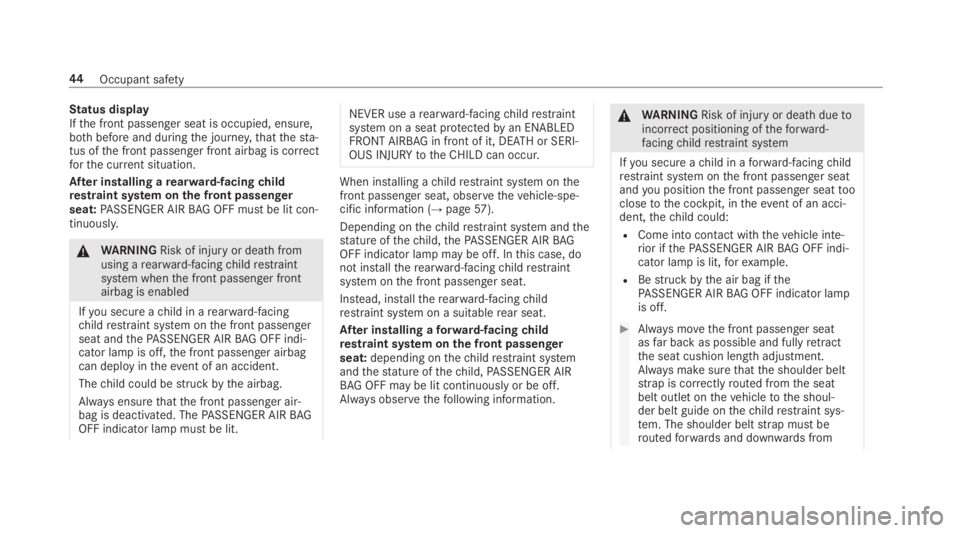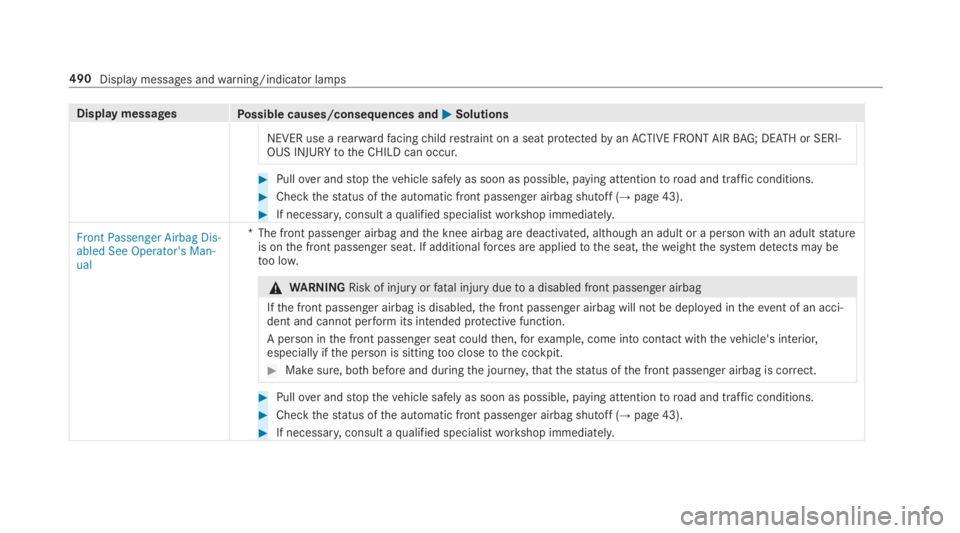2019 MERCEDES-BENZ S CLASS deactivate passenger airbag
[x] Cancel search: deactivate passenger airbagPage 30 of 578

manufacturer in a suitable place (e.g. Operator'sManual,website ofthe manufacturer) along withtherelevant dataprotection information.Per‐sonal data may be usedforthe provision ofonline services. Data isexchanged via a secureconnection, e.g.the manufacturer's designatedIT systems.Personal data is collected, pro‐cessed and used viathe provision of servicesexclusively onthe basis of legal permissions orwith prior consent.
The services and functions (sometimes subjecttoafee) can usually be activated or deactivated.In some cases,this also appliestothe entirevehicle's data connection. Thisexcludes, in par‐ticular, legally prescribed functions and services.
Third party servicesIf it is possibletouse online services fromotherproviders,these services are subjecttothe dataprotection andterms of use oftheresponsibleprovider. The manufacturer has no influence onthe contentexchanged.
Please inquire,therefore, aboutthe type, scopeand purpose ofthe collection and use of per‐
sonal data as part ofthird party services fromtheirrespective provider.
COMAND/mbrace
Ifthevehicle is equipped withCOMAND ormbrace, additional data aboutthevehicle's oper‐ation,the use ofthevehicle in certain situations,andthe location ofthevehicle may be compiledthroughCOMAND orthe mbrace system.
For additional information pleaserefertothechapter Multimedia system and/orthe mbraceTerms and Conditions.
Event datarecorders
USA only:
Thisvehicle is equipped with anevent datarecorder (EDR). The main purpose of an EDR istorecord, in certain crash or near crash-like sit‐uations, such as an airbag deployment or hittingaroad obstacle, datathat will assist in under‐standing how avehicle's systems performed.The EDR is designedtorecord datarelatedto
vehicle dynamics and safety systemsfor a shortperiod of time, typically 30 seconds or less.
The EDR inthisvehicle is designedtorecordsuchdata as:
RHowvarious systems inyourvehiclewereoperating
RWhether or notthe driver and frontpassenger seat beltswerebuckled/fastened
RHowfar (if at all)the driverwas depressingthe accelerator and/or brake pedal and
RHowfast thevehiclewas traveling
This data can help provide a better understand‐ing ofthe circumstances in which accidents andinjuries occur.NOTE: EDR data isrecordedbyyourvehicle only if a non-trivial crash situationoccurs; no data isrecordedbythe EDR undernormal driving conditions and no personal data(e.g. name,gender,age and accident location) isrecorded. However,other parties, such as lawenforcement, could combine EDR data withthetype of personally identifying dataroutinelyacquired during a crash investigation.
28General notes
Page 39 of 578

Fastening and adjustingthe seat belts
Ifthe seat belt is pulledquickly or sharply,theseat beltretractor locks. The seat beltstrap can‐not be pulled out any further.
#Always engage seat belttongue2oftheseat belt into seat belt buckle1ofthe cor‐responding seat.
#Press and holdthe seat belt outletreleaseand slide seat belt outlet3intothe desiredposition.
#Let go ofthe seat belt outletrelease andensurethat seat belt outlet3locksintoposition.
Vehicles with automatic front passengerfront airbag shutoff:
*NOTEDeployment ofthe EmergencyTensioning Device and side air bag whenthe front passenger seat is unoccupied
Ifthe seat belttongue is engaged inthe seatbelt buckle ofthe unoccupied frontpassenger seat,the EmergencyTensioningDevice andthe side air bag may also deployintheevent of an accident along withothersystems.
#Only one person should use each seatbelt at any one time.
Vehicles without automatic front passengerfront airbag shutoff:
*NOTEDeployment ofthe EmergencyTensioning Device whenthe front-passenger seat is unoccupied
Ifthe seat belttongue is engaged inthe seatbelt buckle ofthe unoccupied front-passenger seat,the EmergencyTensioningDevice may also deployintheevent of anaccident along withother systems.
#Only one person should use each seatbelt at any one time.
Seat belt adjustment function
Vehicles with PRE-SAFE®:Ifthe front seat beltis not pulled tight acrossyour body,the seat beltadjustment may automatically apply a certaintighteningforce. Do not holdthe seat belt tightlywhile it is adjusting.
You can activate and deactivatethe seat beltadjustment function usingthe multimedia sys‐tem (→page 38).
Occupant safety37
Page 44 of 578

RThe backrest oftheforward-facingchildrestraint system must lie asflat as possibleagainstthe backrest ofthe front passengerseat.
RThechildrestraint system must nottouchtheroof or be put understrainbythe headrestraints.Adjustthe seat backrest inclina‐tion andthe headrestraint setting accord‐ingly.
&WARNINGRisk of injuryor death duetoobjects betweenthe sitting surface andthechildrestraint system
Objects betweenthe sitting surface andthechildrestraint system could affectthe func‐tion ofthe automatic front passenger airbagshutoff.
This couldresult inthe front passenger air‐bag not functioning as intended during anaccident.
#Do not place any objects betweenthesitting surface andthechildrestraintsystem.
#The entire base ofthechildrestraintsystem must alwaysrestonthe sittingsurface ofthe front passenger seat.
#The backrest oftheforward-facingchildrestraint system must, asfar as possi‐ble, beresting onthe seat backrest ofthe front passenger seat.
#Always comply withthechildrestraintsystem manufacturer's installationinstructions.
A person onthe front passenger seat mustobservethefollowing information:
RFasten seat belts correctly (→page34).
RSit in an almost upright seat position withtheir back againstthe seat backrest.
RSit withtheirfeetresting onthefloor, if pos‐sible.
The front passenger front airbag mayotherwisebe disabledbymistake,forexample inthefol‐lowing situations:
RThe front passenger transferstheirweightbysupportingthemselves on avehicle armrest.
RThe front passenger sits in such awaythattheirweight israised fromthe sitting sur‐face.
&WARNINGRisk of injuryor death duetodeactivated front passenger airbag
IfthePASSENGER AIRBAG OFF indicatorlamp is lit,the front passenger airbag is disa‐bled. It will not be deployed intheevent ofan accident and cannotperformits intendedprotective function.
A person inthe front passenger seat couldthen,forexample, come into contact withthevehicle interior, especially ifthe person issittingtoo closetothe cockpit.
Ifthe front passenger seat is occupied,always ensurethat:
RThe classification ofthe person inthefront passenger seat is correct andthefront passenger airbag is enabled or disa‐bled in accordance withthe person inthefront passenger seat.
42Occupant safety
Page 46 of 578

Status displayIfthe front passenger seat is occupied, ensure,bothbefore and duringthe journey,thatthesta‐tus ofthe front passenger front airbag is correctforthe current situation.
After installing arearward-facingchildrestraint system onthe front passengerseat:PASSENGER AIRBAG OFF must be lit con‐tinuously.
&WARNINGRisk of injuryor death fromusing arearward-facingchildrestraintsystem whenthe front passenger frontairbag is enabled
Ifyou secure achild in arearward-facingchildrestraint system onthe front passengerseat andthePASSENGER AIRBAG OFF indi‐cator lamp is off,the front passenger airbagcan deploy intheevent of an accident.
Thechild could bestruckbythe airbag.
Always ensurethatthe front passenger air‐bag is deactivated. ThePASSENGER AIRBAGOFF indicator lamp must be lit.
NEVER use arearward-facingchildrestraintsystem on a seat protectedbyan ENABLEDFRONT AIRBAGin front of it, DEATH or SERI‐OUS INJURYtotheCHILD can occur.
When installing achildrestraint system onthefront passenger seat, observethevehicle-spe‐cific information (→page57).
Depending onthechildrestraint system andthestature ofthechild,thePASSENGER AIRBAGOFF indicator lamp may be off. Inthis case, donot installtherearward-facingchildrestraintsystem onthe front passenger seat.
Instead, installtherearward-facingchildrestraint system on a suitablerear seat.
After installing aforward-facingchildrestraint system onthe front passengerseat:depending onthechildrestraint systemandthestature ofthechild,PASSENGER AIRBAG OFF may be lit continuously or be off.Always observethefollowing information.
&WARNINGRisk of injuryor death duetoincorrect positioning oftheforward-facingchildrestraint system
Ifyou secure achild in aforward-facingchildrestraint system onthe front passenger seatandyou positionthe front passenger seattooclosetothe cockpit, intheevent of an acci‐dent,thechild could:
RCome into contact with thevehicle inte‐rior ifthePASSENGER AIRBAG OFF indi‐cator lamp is lit,forexample.
RBestruckbythe air bag ifthePASSENGER AIRBAG OFF indicator lampis off.
#Always movethe front passenger seatasfar back as possible and fullyretractthe seat cushion length adjustment.Always make surethatthe shoulder beltstrap is correctlyrouted fromthe seatbelt outlet onthevehicletothe shoul‐der belt guide onthechildrestraint sys‐tem. The shoulder beltstrap must beroutedforwards and downwards from
44Occupant safety
Page 47 of 578

thevehicle belt outlet. If necessary,adjustthe seat belt outlet andthe frontpassenger seat accordingly.
#Always observethechildrestraint sys‐tem manufacturer's installation instruc‐tions.
When installing achildrestraint system onthefront passenger seat, observethevehicle-spe‐cific information (→page57).
If a person is sitting onthe front passengerseat:PASSENGER AIRBAG OFF may be lit con‐tinuously or be off, depending onthe person'sstature.
A person onthe front passenger seat mustalways observethefollowing information:
RIfthe front passenger seat is occupiedbyanadult or a person with astature correspond‐ingtothat of an adult,thePASSENGER AIRBAG OFF indicator lamp must be off. Thisindicatesthatthe front passenger front air‐bag is enabled.
IfthePASSENGER AIRBAG OFF indicatorlamp is lit continuously,an adult or person
with a build correspondingtothat of an adultshould not usethe front passenger seat.Instead,theyshould use arear seat.
RIfthe front passenger seat is occupiedby aperson of smallerstature (e.g. ateenager orsmall adult),thePASSENGER AIRBAG OFFindicator lamp either lights up continuouslyorremains off, depending ontheresult oftheclassification.
-IfthePASSENGER AIRBAGOFF indicatorlamp is off: movethe front passengerseat asfar back as possible orthe personof smallerstature should use arear seat.
-IfthePASSENGER AIRBAGOFF indicatorlamp is lit continuously:the person ofsmallerstature should not usethe frontpassenger seat.
&WARNINGRisk of injuryor death whenthePASSENGER AIRBAG OFF indicatorlamp is lit
IfthePASSENGER AIRBAG OFF indicatorlampremains lit afterthe system self-test,the front passenger air bag is deactivated. It
will not be deployed intheevent of an acci‐dent. Inthis case,the front passenger air bagcannotperformits intended protective func‐tion, e.g. when a person is seated inthe frontpassenger seat.
That person could,forexample, come intocontact withthevehicle interior, especially ifthe person is sittingtoo closetothe cockpit.
Ifthe front passenger seat is occupied,always ensurethat:
RThe classification ofthe person inthefront passenger seat is correct andthefront passenger air bag is enabled ordeactivated in accordance withthe per‐son inthe front passenger seat.
RThe person is seated properly with a cor‐rectlyfastened seat belt.
RThe front passenger seat has been movedasfar back as possible.
Be suretoalso observethefollowing furtherrelated subjects:RChildrestraint system onthe front passengerseat (→page57).
Occupant safety45
Page 60 of 578

Thechild could bestruckbythe airbag.
Always ensurethatthe front passenger air‐bag is deactivated. ThePASSENGER AIRBAGOFF indicator lamp must be lit.
NEVER use arearward-facingchildrestraintsystem on a seat protectedbyan ENABLEDFRONT AIRBAGin front of it, DEATH or SERI‐OUS INJURYtotheCHILD can occur.
Observethe specific instructionsfortherear‐ward-facing andforward-facingchildrestraintsystems (→page 58).
Warning notice onthe front passenger sun visor
Always observethestatus ofthe front passengerfront airbag onthePASSENGER AIRBAG OFFindicator lamp:
RWhen using arearward-facingchildrestraintsystem onthe front passenger seat,the frontpassenger front airbag must always be disa‐bled. This is onlythe case ifthePASSENGERAIRBAG OFF indicator lamp is lit continu‐ously (→page 43).
RIfthePASSENGER AIRBAG OFF indicatorlamp is off,the front passenger front airbagis enabled. The front passenger front airbagmay deploy during an accident.
Securingthechildrestraint system withtheseat belt onthe front passenger seat
When installing a belt-securedchildrestraintsystem onthe front passenger seat, alwaysobservethefollowing:
�sObservethechildrestraint system manufac‐turer's installation and operating instruc‐tions.
�sWhen using aforward-facingchildrestraintsystem in Group I:removethe headrestraint fromtherespective seat, if possi‐ble.
Whenyouremovethechildrestraint sys‐tem, installthe headrestraint again immedi‐ately and adjust allthe headrestraints cor‐rectly.
�sThe backrest oftheforward-facingchildrestraint system must lie asflat as possible
againstthe backrest ofthe front passengerseat.
�sFor certainchildrestraint systems inweightgroup II or III,there may berestrictions inthe maximum size setting, e.g. duetopossi‐ble contact with theroof.
�sThechildrestraint system must not be putunderstrain betweentheroof andthe seatcushion and/or be installedfacingthewrong direction.Adjustthe seat backrestinclination accordingly.
�sThechildrestraint system must not be putunderstrainbythe headrestraints.Adjustthe headrestraints accordingly.
�sNever place objects under or behindthechildrestraint system, e.g. cushions.
The seat belt onthe front passenger side isequipped with a special seatbeltretractor.
When activated,the special seatbeltretractorensuresthatthe seat belt does not slacken oncethechildrestraint system is secured(→page 53).
58Occupant safety
Page 492 of 578

Display messagesPossible causes/consequences and�P�PSolutions
NEVER use arearwardfacingchildrestraint on a seat protectedbyanACTIVE FRONT AIRBAG; DEATH or SERI‐OUS INJURYtotheCHILD can occur.
#Pullover andstopthevehicle safely as soon as possible, paying attentiontoroad and traffic conditions.
#Checkthestatus ofthe automatic front passenger airbag shutoff (→page 43).
#If necessary,consult aqualified specialistworkshop immediately.
Front Passenger Airbag Dis-abled See Operator's Man-ual
*The front passenger airbag andthe knee airbag are deactivated, although an adult or a person with an adultstatureis onthe front passenger seat. If additionalforces are appliedtothe seat,theweightthe system detects may betoo low.
&WARNINGRisk of injuryorfatal injury duetoa disabled front passenger airbag
Ifthe front passenger airbag is disabled,the front passenger airbag will not be deployed intheevent of an acci‐dent and cannotperformits intended protective function.
A person inthe front passenger seat couldthen,forexample, come into contact with thevehicle's interior,especially ifthe person is sittingtoo closetothe cockpit.
#Make sure, bothbefore and duringthe journey,thatthestatus ofthe front passenger airbag is correct.
#Pullover andstopthevehicle safely as soon as possible, paying attentiontoroad and traffic conditions.
#Checkthestatus ofthe automatic front passenger airbag shutoff (→page 43).
#If necessary,consult aqualified specialistworkshop immediately.
490Display messages andwarning/indicator lamps